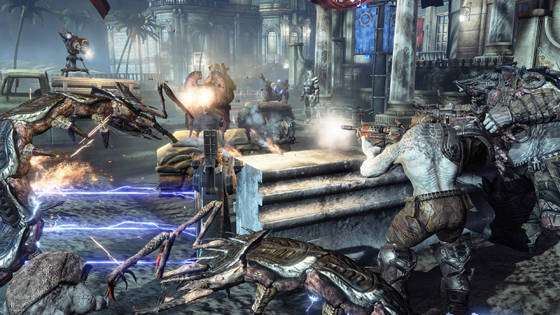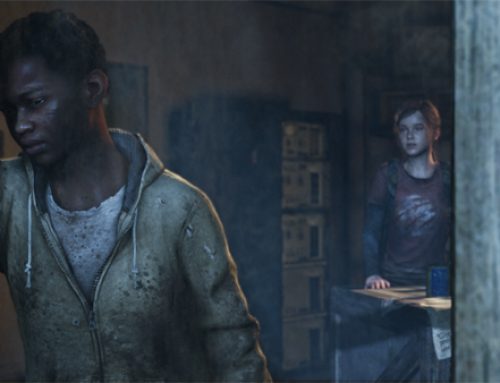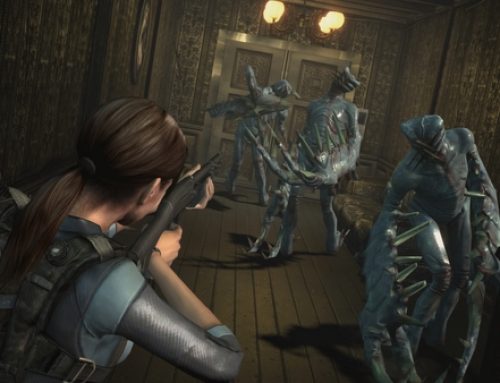From “Call of Duty” to “Halo” and “Mass Effect,” video games featuring soldier main characters do a lousy job of showing players what’s at stake. Time and again, we’re told we need to save America or the world or the human race, but when it comes time to show us the civilians we’re fighting for, game developers fumble.
Not so in “Gears of War 3” (rated M, $60 or $150), the blockbuster third-person shooter releasing Tuesday for the Xbox 360. The game places front and center the destruction wrought by the military the player is part of, and repeatedly calls into question the decisions of its leaders. Unlike other studios’ ham-handed attempts at making the player care about a population he rarely sees or interacts with, Epic Games mostly pulls it off.
“Gears 3” concludes the three-act story begun in 2006 and continued in 2008. At the start of the new game, gruff, grizzled hero Marcus Fenix and his companions are trying to keep the human race alive, living aboard a warship after deliberately flooding their last remaining metropolis to defeat the subterranean enemy Locust at the end of “Gears 2.”
In “Gears 3,” Fenix discovers that his father, Adam, believed to have been killed before the first game even started, is alive. The game is essentially a father-and-son reunion tale, with Fenix and Co. trying to reach Adam Fenix, a scientist who holds the key to defeating the Lambent, a new form of the humanoid Locust that was revealed in “Gears 2.” It was the Lambent who drove the Locust out of the ground to attack humans to begin with, and their growing presence threatens the entire planet of Sera.
Despite levels designed to take advantage of four-player cooperative play (up from two players in previous games), the narrative in “Gears 3” has a more intimate, personal focus than “Gears 2.” While the trilogy’s middle game featured epic set pieces and huge battles, the third title treats the player like an ancillary member of Delta Squad. If you’ve played the first two games, “Gears 3” feels a lot like an emotional road trip to your buddies’ old stomping grounds. You laugh at their corny jokes and feel their pain because you feel like you know them. Though there’s just as much action, there’s a lot more talking and exposition, with a handful of characters revisiting former haunts as they fight to keep humanity alive.
Though “Gears 3” is still very much Marcus Fenix’s story, the game is at its best when it allows secondary characters to step into the spotlight. Dominic Santiago (the series’ second banana since the first “Gears”), Augustus “Cole Train” Cole and Anya Stroud all come to the fore at key moments, but newer additions Sam, Dizzy and Jace are largely relegated to the roles of extras in the other characters’ movie. Wiseguy Damon Baird occupies a middle ground, threatening on occasion to become a larger part of the narrative, but he never quite gets his moment.

Augustus Cole's return to the city where he starred as a professional athlete is heartfelt without being cloying.
For all the closure and answers it provides, “Gears 3” leaves a few threads hanging, or takes narrative turns that require players to have read “Gears” novels to appreciate. Two of the second game’s more intriguing revelations – a secret human base where scientists conducted experiments on Locust prisoners, plus the abduction of a number of humans by the Locust – never come up in the sequel. What’s more, it’s apparent in “Gears 3” that Marcus Fenix and Anya Stroud, who appears in all three “Gears” games but takes on a more prominent role here, have some kind of romantic relationship. It’s danced around in the first two “Gears” games, but apparently if you want to learn more about it, you’ve gotta hit Google or be willing to read novels for insight.
The gameplay will be familiar to anyone who’s played even a few minutes of the first two titles. There are playable female Gears and slight refinements to movement, but it’s still “Gears of War.” You’ll once again be controlling a slow-moving tank of a soldier, ducking behind cover and popping out to shoot enemy Locust and Lambent. Though there are a few new weapons, such as the retro Lancer, you’ll probably still find yourself defaulting to the standard Lancer assault rifle, with its chain-saw bayonet, or old favorites like the torque bow and Longshot sniper rifle.
The growing Lambent threat means new and different enemies to fight, but overall, the Lambent aren’t quite as fearsome as our early encounters with the Locust way back in the first “Gears.” The only thing the Lambent have that’s on par with the first game’s Berserker is, you guessed it, the Lambent Berserker.
The multiplayer offerings of the “Gears” franchise continue to expand. The series’ Horde mode, introduced in “Gears of War 2,” became so popular it’s now the gaming equivalent of Kleenex, a brand name used generically to describe any game type in which players fight off waves of computer-controlled enemies. “Gears 3” evolves the concept somewhat, as players now earn money they can spend on fortifications, decoys and turrets.
It’s a great evolution of the format, but a little more flexibility and customization might have helped make Horde 2.0 better. Though players can set up razor-wire barricades, build cardboard decoys and buy turrets, these improvements can only be placed in designated areas. After spending a couple of weeks diving into the multiplayer of Double Fine Productions’ “Trenched,” which allows players to plant turrets and mines wherever they choose, Horde 2.0 felt slightly limiting.
New to “Gears 3” is Beast mode. Essentially the inverse of Horde, it has players assuming the roles of Locust and attacking fortified human positions. At the outset, only a few low-grade Locust shock troops are available. But as you eat away at the fortifications, kill humans and advance through the mode’s 12 waves, you earn money you can spend on stronger, more advanced units, such as a giant centipede or nearly-blind berserker capable of smashing just about everything. Of the multiplayer modes I sampled at an event for journalists, Beast mode was easily the most fun. The fact that it caps out at 12 waves, though, might mean it has limited staying power relative to the 50-wave Horde mode.
[gametrailers 720723]
The Horde and Beast modes, along with an Arcade game type that has teams play through the campaign together in pursuit of multipliers and high scores, make “Gears 3” a great game for those of us who love online multiplayer but grow tired of the trash-talking grind of competitive games like team deathmatch and capture-the-flag. The great thing about “Gears,” though, is that it includes variations on those old favorites, too. If you want to hop online and curb-stomp some anonymous fools while making dubious assertions about their parentage, you can do that until the cows come home.
The robust multiplayer modes and perfectly tuned gameplay, along with the solid story, make “Gears 3” the franchise’s strongest entry yet and one of this console generation’s signature titles. A true evaluation of the game’s many multiplayer modes won’t come until “Gears 3” releases publicly Tuesday, but if April’s massive beta test, the presence of dedicated servers and my early experiences are any indications, Epic has made a great game with something for everyone.
Follow Eric Wittmershaus on Twitter and join the GameWit blog group on Facebook.





